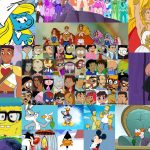Superheroes and Supervillains: Comic books have long been a staple of popular culture, captivating readers with their colorful characters, epic battles, and fantastical worlds. At the heart of the comic book universe are:
- Superheroes and supervillains.
- Iconic characters with extraordinary abilities.
- Engaging in epic conflicts of good versus evil.
In this analysis, we will explore the colorful world of comic book characters, examining the origins, evolution, and enduring appeal of superheroes and supervillains in popular culture.

1. Origins and Evolution:
The origins of comic book characters can be traced back to the early 20th century, with the emergence of characters like Superman, Batman, and Wonder Woman in the pages of comic strips and pulp magazines. These early characters established the superhero genre, introducing readers to larger-than-life heroes with extraordinary powers and abilities.

As the medium evolved, so did the characters and stories within it. The Golden Age of Comics, which spanned the late 1930s to the early 1950s, saw the rise of iconic superheroes like Captain America, the Flash, and the Green Lantern, who fought villains and protected the innocent in a world threatened by war and chaos.

The Silver Age of Comics, which began in the late 1950s and continued into the 1970s, introduced a new generation of superheroes with more complex personalities and motivations. Characters like Spider-Man, the X-Men, and the Fantastic Four grappled with personal struggles and moral dilemmas while battling larger-than-life villains and saving the world from destruction.

In the modern era of comics, which began in the 1980s and continues to present, superheroes have become more diverse and multifaceted, reflecting the changing social and cultural landscape. Characters like Black Panther, Captain Marvel, and Ms. Marvel have broken new ground by representing marginalized communities and addressing contemporary issues like racism, sexism, and environmentalism.

2. Archetypes and Iconography:
Superheroes and supervillains are defined by a rich tapestry of archetypes and iconography that have become synonymous with the genre. From the caped crusader to the man of steel, comic book characters are often characterized by their distinctive costumes, powers, and abilities, which serve as visual shorthand for their identities and motivations.

The superhero archetype typically embodies courage, strength, and selflessness, while the supervillain archetype represents traits like power, greed, and nihilism. These archetypes are often reflected in the visual design of the characters, with heroes typically depicted in bright, primary colors and villains in darker, more menacing hues.

Moreover, comic book characters often possess unique powers and abilities that set them apart from ordinary humans. From super strength and flight to telekinesis and shape-shifting, superheroes and supervillains possess a wide range of powers that allow them to perform extraordinary feats and engage in epic battles on a cosmic scale.

3. Moral Complexity and Character Development:
One of the hallmarks of comic book characters is their moral complexity and character development, which adds depth and nuance to their personalities and motivations. While superheroes are typically portrayed as paragons of virtue, they are not immune to moral ambiguity and internal conflict.

Characters like Batman and Wolverine grapple with inner demons and personal traumas while fighting crime and protecting the innocent. Similarly, supervillains like Magneto and the Joker are often portrayed as tragic figures whose villainy stems from past traumas and injustices.

This moral complexity and character development add depth and richness to comic book characters, making them more relatable and compelling to readers. Whether they’re struggling with issues of identity, morality, or redemption, superheroes and supervillains often undergo profound personal growth and transformation throughout their journeys, reflecting the complexities of the human experience.

4. Enduring Themes and Cultural Impact:
Comic book characters explore many themes and ideas that resonate with readers of all ages and backgrounds. From the timeless struggle of good versus evil to the power of redemption and the importance of friendship and teamwork, comic book characters offer valuable insights into the human condition and the universal quest for meaning and purpose.

Moreover, comic book characters have had a profound cultural impact, shaping how we view heroes, villains, and the world around us. From the iconic imagery of Superman’s cape to the moral complexity of characters like Batman and the X-Men, comic book characters have become ingrained in popular culture, inspiring countless adaptations, reimaginings, and reinterpretations across various mediums.

The influence of comic book characters can be seen in film, television, literature, fashion, and beyond, with superheroes and supervillains becoming beloved icons that transcend the boundaries of the comic book medium. Whether fighting crime on the silver screen or inspiring new generations of fans through animated series and merchandise, comic book characters continue to captivate audiences worldwide with their timeless appeal and enduring legacy.

5. Fan Culture and Community:
Finally, comic book characters have fostered a vibrant fan culture and community that celebrates their love for the medium and its iconic characters. From comic book conventions to online forums and fan communities, comic book fans come together to share their passion for superheroes and supervillains, discuss their favorite characters, share fan art and fan fiction, and engage in spirited debates about the merits of different storylines and interpretations.

This sense of community and camaraderie is a testament to the enduring appeal of comic book characters and the profound impact they have had on fans’ lives. Whether dressing up as their favorite superheroes for cosplay events or participating in charity fundraisers and community outreach programs, comic book fans find connection and belonging through their shared love of comic book characters and culture.

Conclusion:
In conclusion, comic book characters have profoundly impacted global pop culture, captivating audiences with their colorful personalities, epic battles, and timeless themes. From the iconic heroes of the Golden Age to the morally complex antiheroes of the modern era, comic book characters continue to inspire and entertain readers of all ages with their rich tapestry of archetypes, iconography, and storytelling.

As the comic book medium continues to evolve and adapt to changing cultural trends and technologies, the legacy of comic book characters will endure, leaving an indelible mark on popular culture for generations to come. Whether fighting for justice, seeking redemption, or embracing their inner darkness, superheroes and supervillains will continue to captivate audiences with their colorful world of adventure and imagination.
Read also
- From Comics to Cartoons: The Transition of Famous Comic Book Characters
- How to Draw Comic Book Characters Easy
- From Page to Screen: The Top 10 Comic Book Cartoon Characters
- The Magical World of Harry Potter: Iconic Movie and Book Characters
- The Impact of Japanese Anime Characters on Global Pop Culture
FAQs about Superheroes and Supervillains: The Colorful World of Comic Book Characters
1. Q: What are superheroes and supervillains?
A: Superheroes are fictional characters with extraordinary abilities or skills who use their powers to protect the innocent and fight against evil forces. Conversely, supervillains are characters who possess similar abilities but use them for selfish or malicious purposes, often opposing the heroes.
2. Q: How do superheroes and supervillains differ from other fictional characters?
A: Superheroes and supervillains typically possess superhuman abilities, wear distinctive costumes, and engage in larger-than-life battles between good and evil, distinguishing them from other fictional characters.
3. Q: What are some examples of iconic superheroes?
A: Iconic superheroes include Superman, Batman, Spider-Man, Wonder Woman, The Hulk, Iron Man, Captain America, and The Flash, among others.
4. Q: Who are some famous supervillains?
A: Famous supervillains include The Joker, Lex Luthor, Magneto, Doctor Doom, Thanos, Loki, Catwoman, and Venom, among others.
5. Q: What is the significance of superheroes and supervillains in comic books?
A: Superheroes and supervillains play a central role in comic book narratives, symbolizing hope, justice, and moral complexity while providing entertainment, escapism, and social commentary.
6. Q: How do comic book creators develop superhero and supervillain characters?
A: Comic book creators develop superhero and supervillain characters by crafting unique origin stories, defining their powers, weaknesses, and motivations, and creating compelling relationships with other characters in their respective universes.
7. Q: Are all superheroes and supervillains human?
A: No, not all superheroes and supervillains are human. Some are aliens, mutants, robots, or mystical beings with diverse backgrounds and origins.
8. Q: What role do costumes play in defining superhero and supervillain characters?
A: Costumes play a crucial role in defining superhero and supervillain characters, serving as visual symbols of their identities, powers, and allegiances while distinguishing them from other characters in the comic book world.
9. Q: How do superhero and supervillain teams differ from individual characters?
A: Superhero and supervillain teams consist of multiple characters who join forces to achieve common goals, whether saving the world or conquering it, whereas individual characters operate solo or in partnership with a sidekick orally.
10. Q: Are there any superhero and supervillain crossovers?
A: Yes, superheroes and supervillain crossovers occur frequently in comic books, resulting in epic clashes, team-ups, alliances, and unexpected alliances between characters from different universes or publishers.
11. Q: Do superheroes and supervillains reflect real-world issues and values?
A: Yes, superheroes and supervillains often serve as metaphors for real-world issues, such as social injustice, inequality, corruption, and the struggle between good and evil, offering commentary and insight into contemporary society.
12. Q: How have superheroes and supervillains evolved?
A: Superheroes and supervillains have evolved in terms of their character designs, powers, personalities, and cultural relevance, reflecting changing societal norms, technological advancements, and storytelling trends.
13. Q: Are there any superhero and supervillain archetypes?
A: Yes, common superhero archetypes include the “boy scout” hero, the “antihero,” the “everyman” hero, and the “outsider” hero, while supervillain archetypes include the “mad scientist,” the “mastermind,” the “tragic villain,” and the “chaotic evil” villain, among others.
14. Q: What impact do superheroes and supervillains have on popular culture?
A: Superheroes and supervillains have a significant impact on popular culture, influencing fashion, merchandise, entertainment, and inspiring fan communities, cosplay, conventions, and fan fiction.
15. Q: Can superheroes and supervillains be morally ambiguous?
A: Yes, some superheroes and supervillains exhibit morally ambiguous traits, making decisions that blur the line between right and wrong, challenging traditional notions of heroism and villainy.
This post was created with our nice and easy submission form. Create your post!




5 Comments